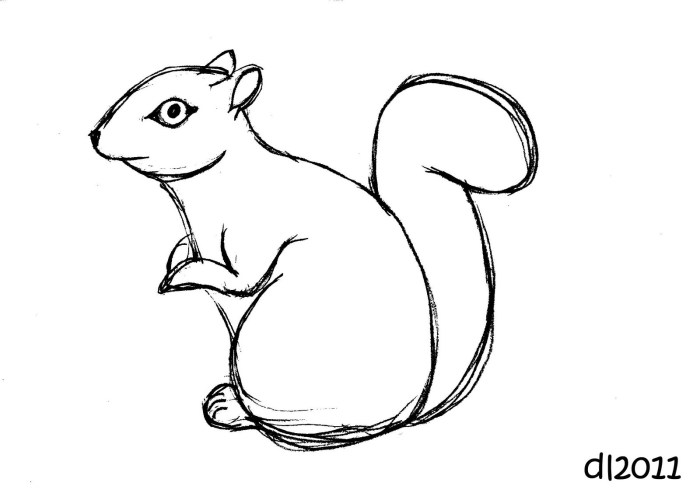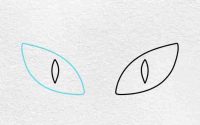Drawing of a Flying Squirrel Easy A Step-by-Step Guide
Table of Contents
ToggleBasic Shapes and Composition

Drawing of a flying squirrel easy – Simplifying the representation of a flying squirrel for drawing purposes involves reducing its complex form to a combination of basic geometric shapes. This approach facilitates understanding the underlying structure and allows for easier reproduction, particularly for beginners. Effective composition further enhances the visual appeal and impact of the drawing.The process of constructing a simplified flying squirrel utilizes overlapping circles, ovals, and triangles to create the illusion of volume and form.
Different compositional strategies can be employed to achieve varying aesthetic effects.
Geometric Shape Representation of a Flying Squirrel
A simplified flying squirrel can be constructed using the following basic shapes: A large oval forms the body. Two smaller, slightly overlapping circles represent the head and the bushy tail. Two smaller ovals, positioned on either side of the body, depict the outstretched patagium (the membrane used for gliding). Small triangles can be added to suggest the ears, and tiny circles represent the eyes.
The limbs can be represented by smaller, elongated ovals or even simple lines. Overlapping these shapes creates depth and visual interest. For instance, the head circle slightly overlaps the body oval, while the tail circle partially overlaps the body oval and the patagium ovals.
Compositional Approaches
Several compositional approaches can be used to arrange the flying squirrel within the drawing space. A centered composition places the squirrel directly in the middle, creating a balanced and symmetrical image. An off-center composition, placing the squirrel to one side, can create a more dynamic and visually engaging piece. The squirrel’s pose also significantly impacts the composition. A dynamic pose, such as the squirrel gliding with outstretched limbs, creates a sense of movement and action, contrasting with a static pose, which might show the squirrel perched on a branch.
Visual Guide: Constructing the Squirrel’s Form
Imagine a large, horizontal oval representing the squirrel’s body. Slightly overlapping the left side of this oval, position a smaller circle for the head. To the right of the body oval, draw a slightly larger circle, overlapping the body, to represent the bushy tail. On either side of the body oval, add two smaller, slightly elongated ovals to depict the patagium, extending outward from the body.
Two small, upright triangles placed atop the head circle represent the ears. Finally, add two tiny circles within the head circle for the eyes. The careful overlapping of these shapes creates a three-dimensional effect, transforming simple geometric forms into a recognizable flying squirrel. Consider varying the size and orientation of the shapes to create different expressions and poses.
For example, tilting the head circle slightly adds character and conveys a sense of movement or alertness.
Exploring Different Drawing Styles: Drawing Of A Flying Squirrel Easy

Representing a flying squirrel artistically involves a stylistic choice impacting the final aesthetic. Different styles emphasize varying aspects of the subject, from anatomical accuracy to expressive simplification. The choice of style dictates the approach to line work, shading, and the overall visual impression.
Comparative Analysis of Cartoon, Realistic, and Stylized Approaches
Cartoon styles prioritize simplification and exaggeration for comedic or whimsical effect. A cartoon flying squirrel might have oversized eyes, a simplified body shape, and exaggerated movements. Realistic representations aim for anatomical accuracy, detailing fur texture, muscle definition, and membrane structure. Stylized drawings blend aspects of realism and abstraction, maintaining recognizable features while employing artistic license in proportions, colors, or textures.
For example, a stylized drawing might emphasize the gliding membrane with vibrant colors, while simplifying other details.
Line Weight and Shading Techniques in Different Styles
Line weight plays a crucial role in conveying form and style. Cartoon drawings often utilize bold, consistent lines, creating a clear silhouette. Realistic drawings use varied line weights to suggest depth and form, with thinner lines for subtle details and thicker lines for contours. Stylized drawings may experiment with line weight to create a specific visual effect, perhaps using thick, expressive lines to define the Artikel and thinner lines for internal details.
Shading techniques also vary. Cartoon styles might use simple flat shading, while realistic drawings employ a range of techniques like hatching, cross-hatching, and blending to create a three-dimensional effect. Stylized drawings might utilize bold color blocks or gradients to achieve their visual impact.
Mastering the art of a simple flying squirrel drawing involves understanding basic shapes and proportions. For a different cartographic challenge, consider the intricacies of an aztec map drawing easy , which offers a fascinating contrast in style and complexity. Returning to our furry friend, remember to focus on the membrane and the expressive eyes to capture the essence of a flying squirrel in your sketch.
Influence of Drawing Mediums
The choice of medium significantly influences the final outcome. Pen and ink drawings create crisp, precise lines, well-suited for cartoon or stylized approaches. Pencil allows for greater flexibility, enabling blending and subtle shading essential for realistic representations. Digital mediums offer a range of tools and effects, providing versatility across all styles. For example, a pencil sketch can easily be refined and colored digitally, blending traditional techniques with digital capabilities.
A pen and ink drawing might benefit from digital cleanup and color adjustment to further enhance its detail. Digital painting allows for more control over texture and color, offering unparalleled flexibility in creating unique stylistic choices. A realistic depiction of a flying squirrel using digital painting might utilize photo-realistic textures, whereas a stylized version might use bold, flat colors and simplified forms.
Illustrative Examples

Three distinct approaches to illustrating a flying squirrel are presented below, each showcasing a different artistic style and level of detail. These examples highlight the versatility of artistic expression when depicting this unique mammal.
Example 1: Detailed Realistic Rendering
This drawing employs a highly realistic style, prioritizing anatomical accuracy and meticulous detail. The artist likely used graphite pencils of varying hardness to achieve a wide range of tones, from the dark shadows in the fur to the subtle highlights on the gliding membrane. Individual hairs might be visible, and the texture of the fur, the delicate membrane, and even the texture of the bark on the tree would be carefully rendered.
The pose might depict the squirrel in mid-glide, showcasing the extended patagium and the characteristic body posture. The overall effect is a scientifically accurate and visually stunning representation, conveying a sense of realism and the animal’s grace. Strengths include the high level of detail and anatomical accuracy. A weakness might be the time and skill required to achieve this level of realism; it is a challenging technique for less experienced artists.
Example 2: Simplified Cartoon Style
This approach uses a simplified, cartoonish style, emphasizing expressive features and playful characterization. The squirrel’s body might be composed of basic shapes, such as circles and ovals, with exaggerated features like large eyes and a small, rounded nose. The lines would be bold and clean, possibly using a single color or a limited palette. The gliding membrane could be simplified into a stylized shape, and the overall effect is a charming and easily accessible representation.
Strengths include its simplicity and appeal to a broad audience, especially children. A weakness is the lack of anatomical detail; the illustration might not be scientifically accurate.
Example 3: Impressionistic Style, Drawing of a flying squirrel easy
This style prioritizes the overall impression and feeling over precise detail. The artist might use loose brushstrokes or blended pencils to create a sense of movement and atmosphere. The squirrel’s form might be suggested rather than precisely defined, with emphasis on the interplay of light and shadow to convey its shape and texture. The colors might be vibrant and expressive, conveying a sense of energy and life.
The background might be equally impressionistic, perhaps using a blurred technique to emphasize the squirrel as the focal point. Strengths lie in the expressive nature of the style and its ability to convey a feeling or mood. A weakness is the lack of fine detail, making it less suitable for those requiring anatomical accuracy.
FAQs
What kind of paper is best for drawing flying squirrels?
Smooth drawing paper works well for pencils, while slightly textured paper can be nice for pen and ink. Experiment to find your favorite!
Can I use digital art software to draw a flying squirrel?
Absolutely! Programs like Procreate, Photoshop, or even free options like Krita are perfect for digital flying squirrel art.
How do I make my flying squirrel look fluffy?
Use light, short strokes to suggest fur, varying the direction and pressure for a more realistic look. You can also add some subtle shading to enhance the fluffiness.
What if my flying squirrel doesn’t look perfect?
Don’t worry! It’s all about the process. Keep practicing, and you’ll see improvement over time. Have fun and don’t be afraid to make mistakes – they’re part of the learning process!
Related posts:
Related Posts

Window on Lightning Drawing Easy

Super Hero Drawing Body Easy A Simplified Guide

